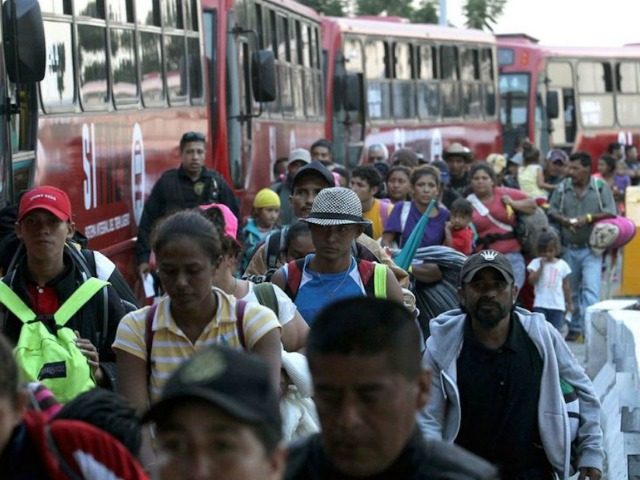Voters lopsidedly oppose the inflow of more immigrants into the United States, according to an August poll by Morning Consult and Politico.
Thirty-two percent of 1,987 respondents said they were “much less likely” to back a candidate who supports “more immigrants coming into the country.”
Only ten percent of respondents said they are “much more likely” to back a more-immigration candidate.
The 3:1 tilt is significant because the voters who said they care “much” about an issue are far more likely to change their vote choice based on the candidate’s views. That is good news for President Donald Trump and his pro-American policies, but it is bad news for the Democrats who have adopted hardline pro-migrant policies.
Overall, 45 percent of respondents said they are “much” or “somewhat” less likely to support a candidate who favors more migration, while only 23 percent said they are “much” or “somewhat” more likely. That larger 2:1 ratio helps shape the public’s mood in a race, helping the low-immigration voters become more vocal and more active against high-immigration candidates.
The Morning Consult poll got similar lopsided results from a second similar question: “When thinking about your vote in the 2020 presidential election, would each of the following make you more or less likely to support a candidate, or would it make no difference either way?”
Thirty-seven percent of respondents said “much less likely” to support “the candidate [who] supported more immigrants coming into the country.” Only 13 percent said “much more likely” to support the pro-migration candidate.
Among independents, the vote split was even stronger — 34 percent said they were “much more likely” to vote for the high-immigration candidate, while only nine percent said they were “much less likely.” Thirty-four percent of independents said that it “makes no difference” or “don’t know [or] have no opinion.” That share is high and may hide additional support for the lower-immigration candidate.
The Morning Consult poll matches prior polls showing independents strongly oppose more migration. Breitbart News reported the result of a Harvard/Harris poll on August 3:
Overall, about 64 percent of registered voters said they would be more unlikely to support a 2020 presidential candidate that backs increasing illegal and legal immigration to the country — including about 63 percent of Generation X voters, 45 percent of Democrats, and 66 percent of voters who describe themselves as “moderate.”
Many polls show hidden opposition to migration. For example, “alternative choice” polls conducted by White House aide Kellyanne Conway in 2013 and 2014 show very strong opposition to immigration policies that allow companies to hire foreign workers in place of unemployed Americans. In contrast, companies fund and tout polls that inflate support for immigration by pushing the 1965 claim that the United States is a “Nation of Immigrants.”
The detailed poll was taken August 23-25, and it provides a more nuanced answer than the annual Gallup polls, which show a rising share of Democrats favoring additional immigration. The data in the Morning Consult poll suggests the apparently rising share of pro-migration Democrats overstates tepid and temporary statements of support for more migration by Democrats who are going along with loud, pro-migration activists in the party.
The poll is also bad news for business groups and legislators who want to import more white-collar visa workers. Those legislators include GOP Sen. Kevin Cramer, who is pushing the S.386 legislation to import more Indian college graduate migrants for jobs in his district that are sought by American graduates.
The growing public consensus against additional migration is a problem for the Democrats’ 2020 presidential nomination, partly because the party’s activist base includes a disproportionate share of the “much more” group. For example, the ten percent “much more likely” group includes 17 percent of Hillary Clinton’s 2016 voters, 18 percent of “Democrat/lean Democrat” respondents, and 19 percent of people who “Vote in Democratic primary or caucus.”
Similarly, 22 percent of registered Democrats — and only nine percent of independents — said they would be “much more likely” to support “the candidate [who] supported getting rid of Immigration and Customs Enforcement, also known as ICE”:
Immigration Numbers:
Each year, roughly four million young Americans join the workforce after graduating from high school or university. This total includes about 800,000 Americans who graduate with skilled degrees in business or health care, engineering or science, software, or statistics.
But the federal government then imports about 1.1 million legal immigrants and refreshes a resident population of about 1.5 million white-collar visa workers — including approximately 1 million H-1B workers and spouses — and about 500,000 blue-collar visa workers.
The government also prints out more than 1 million work permits for foreigners, it tolerates about 8 million illegal workers, and it does not punish companies for employing the hundreds of thousands of illegal migrants who sneak across the border or overstay their legal visas each year.
This policy of inflating the labor supply boosts economic growth for investors because it transfers wages to investors and ensures that employers do not have to compete for American workers by offering higher wages and better working conditions.
This policy of flooding the market with cheap, foreign, white-collar graduates and blue-collar labor also shifts enormous wealth from young employees towards older investors, even as it also widens wealth gaps, reduces high-tech investment, increases state and local tax burdens, and hurts children’s schools and college educations.
The cheap-labor economic strategy also pushes Americans away from high-tech careers and sidelines millions of marginalized Americans, including many who are now struggling with fentanyl addictions.
The labor policy also moves business investment and wealth from the Heartland to the coastal cities, explodes rents and housing costs, undermines suburbia, shrivels real estate values in the Midwest, and rewards investors for creating low-tech, labor-intensive workplaces:

COMMENTS
Please let us know if you're having issues with commenting.